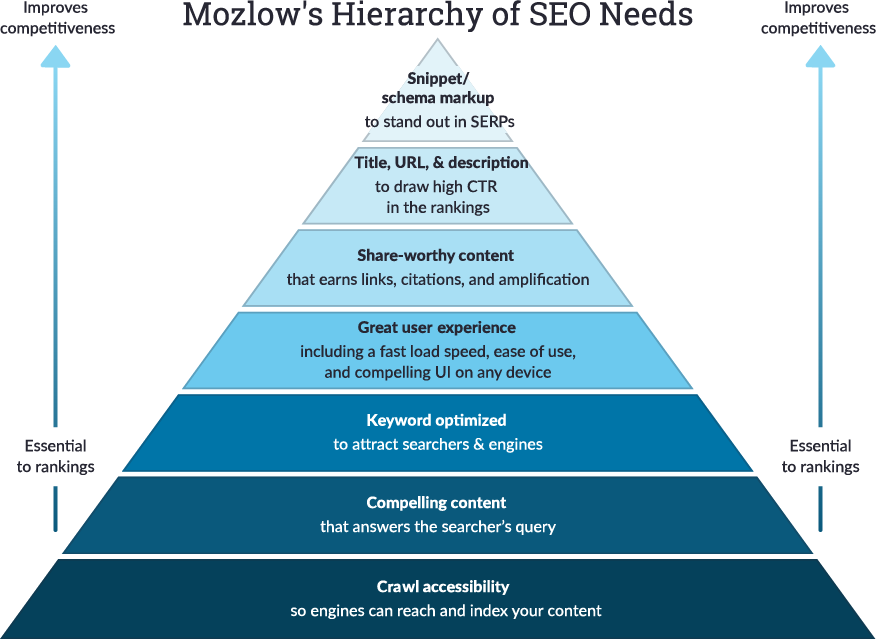Getting started with SEO requires understanding the concepts the positively and negatively impact your search rankings. In this discussion, we will be using the popular framework of the hierarchy of needs. Note: the image associate with this post is from https://moz.com/beginners-guide-to-seo and they retain all copyright.
Maslow’s hierarchy of needs
From Simply Psychology:
“Maslow’s hierarchy of needs is a motivational theory in psychology comprising a five-tier model of human needs, often depicted as hierarchical levels within a pyramid.
From the bottom of the hierarchy upwards, the needs are: physiological (food and clothing), safety (job security), love and belonging needs (friendship), esteem, and self-actualization.
Needs towards the bottom of the hierarchy must be satisfied before individuals can attend to needs higher up.”
Applying this to SEO
This is a great framework to understand motivations and thinking based on priority needs that should be fulfilled first. While this framework is specifically tied to psychosocial applications, it can be used to understand a complex topic, like Search Engine Optimization (SEO).
If you are new to SEO, there is no magic bullet or short term fix. It takes time to get the elements in place which include: on-site technical code, off-site linking, content, and content structure. While these are complex and take time, there is no reason you can’t start with the most important elements and build good SEO practices so your site will rank.
The SEO hierarchy of needs was developed by MOZ and helps us understand where to start. We will walk through each of these elements and give you an idea how it can apply to your small business. Think of it as building blocks, and you shouldn’t focus on the next stage until you have completed (or have an ongoing strategy to complete) the previous phase.
Crawl Accessibility
You can’t rank if search engines can’t read your website. Ensuring your website is accessible to search engines and easy to read (from a computer’s standpoint) is essential.
Here is an understanding of crawlability from Yoast:
“There are a few things that could prevent Google from crawling (or indexing) your website:
- If your robots.txt file blocks the crawler, Google will not come to your website or specific web page.
- Before crawling your website, the crawler will take a look at the HTTP header of your page. This HTTP header contains a status code. If this status code says that a page doesn’t exist, Google won’t crawl your website. In the module about HTTP headers of our Technical SEO training we’ll tell you all about that.
- If the robots meta tag on a specific page blocks the search engine from indexing that page, Google will crawl that page, but won’t add it to its index.”
Here is the process in visual form:
Compelling Content
Compelling content is essential for SEO. Compelling content basically boils down to how well you are answering questions users have.
To be considered compelling, content should be written to solve specific problems for an audience. This includes both carefully understanding your audience and writing for your audience. Content that is geared towards an audience and is well written will be much more effective in your SEO efforts.
Make sure to never write content specifically geared to manipulate search engines. Search engines are smart (Google isn’t worth a trillion dollars by accident) so they won’t be tricked in the long run. Don’t keyword stuff or any other tactics meant simply to rank.
Keyword Optimization
Keyword optimization selecting the right keywords that are relevant to your audience. This means:
- Understanding the keywords your audience uses to find content
- Understanding the derivatives of those keywords
- Understanding where you might compete for specific keywords
Once you understand your keywords, you may begin to craft a strategy to leverage those keywords that are beneficial to your audience.
Great User Experience
A great user experience is the next stage of SEO. Great user experiences result in happy users as well as indicators that your site is great to search engines. For example, if you have a high bounce rate and short time on site this can indicate your site is not relevant or that the user experience is poor.
Site speed is an important indicator of user experience as well. Think – CNN is a great website with tons of relevant news content. However, if each page on CNN took 30 seconds to load, would you rate that as a great experience? Search engines know the time it takes for your pages to load, and use that as a factor for rankings.
Share Worthy Content
Simply put, most users want to share great content. The better your content, the more shares you will get, the more backlinks you might receive, and the higher you may rank in the search engines. Before posting content, make sure to ask yourself if the content you are sharing is truly share worthy in the niche you are in.
Title, URL, and Description
Users view a limited amount of information when they view search results. Most users will scan the titles and description of the first few results on the first page. In fact, the first position gets around 25% or more of clicks. It is imperative that you do all you can to make sure users understand your site and how it might be important for them to click on your result, especially if you are not in the #1 spot.
This by no means you should be spammy at all. This simply means spending the time to evaluate and craft your titles and descriptions to give users an accurate picture of your website in relation to your keywords.
Snippet/Schema markup
If you have ever searched for a recipe, you will see succinct results for a recipe in the top results. Here is an example for cornbread:
Google has specific schemas for various types of data including events, books, how-to, job postings, products, and much much more. The fact is that google didn’t simple guess that the search results were recipes for delicious cornbread. The recipe was coded in a way so that good knew it was a recipe, and was provided with the right data to display it as a recipe listing.
If your results include anything outside of web text, review the schemas to see if you can help Google rank your site better with the appropriate schema. Review the full list of Google schemas for more information.
Hopefully, this information will provide more structure on how to craft an SEO strategy for your site, and where you should focus your efforts to get started.




